ZK Failover Controller Design
Todd Lipcon
todd@cloudera.com
April 3, 2012
Contents
1 Overview
1.1 Background . . . . . . . . . . . . . . . . . . . . . . . . . . . . . . . . . . . . . . . . . . . . . .
1.2 ZooKeeper-based approach . . . . . . . . . . . . . . . . . . . . . . . . . . . . . . . . . . . . .
2 Design
2.1 Components . . . . . . . . . . . . . . . . . . . . . . . . . . . . . . . . . . . . . . . . . . . . . .
2.2 HealthMonitor design . . . . . . . . . . . . . . . . . . . . . . . . . . . . . . . . . . . . . . . .
2.3 ActiveStandbyElector design . . . . . . . . . . . . . . . . . . . . . . . . . . . . . . . . . . . .
2.4 ZKFC Design . . . . . . . . . . . . . . . . . . . . . . . . . . . . . . . . . . . . . . . . . . . . .
2.5 Fencing . . . . . . . . . . . . . . . . . . . . . . . . . . . . . . . . . . . . . . . . . . . . . . . .
2.6 ZKFC State machine diagram . . . . . . . . . . . . . . . . . . . . . . . . . . . . . . . . . . . .
2.7 Supporting manual failover in conjunction with automatic . . . . . . . . . . . . . . . . . . . .
2.7.1 Configuration . . . . . . . . . . . . . . . . . . . . . . . . . . . . . . . . . . . . . . . . .
2.7.2 Manual Failover Operation . . . . . . . . . . . . . . . . . . . . . . . . . . . . . . . . .
3 Example scenarios
3.1 Active NN JVM crash . . . . . . . . . . . . . . . . . . . . . . . . . . . . . . . . . . . . . . . .
3.2 Active NN JVM freeze (e.g SIGSTOP) . . . . . . . . . . . . . . . . . . . . . . . . . . . . . . .
3.3 Active NN machine crash . . . . . . . . . . . . . . . . . . . . . . . . . . . . . . . . . . . . . .
3.4 Active NN goes unhealthy . . . . . . . . . . . . . . . . . . . . . . . . . . . . . . . . . . . . . .
3.5 Active ZKFC crashes . . . . . . . . . . . . . . . . . . . . . . . . . . . . . . . . . . . . . . . . .
3.6 ZooKeeper crash . . . . . . . . . . . . . . . . . . . . . . . . . . . . . . . . . . . . . . . . . . .
4 Details yet to be ironed out
Integrating manual failover
4.1
5 Future work
. . . . . . . . . . . . . . . . . . . . . . . . . . . . . . . . . . . . .
5.1 Preferential nodes
. . . . . . . . . . . . . . . . . . . . . . . . . . . . . . . . . . . . . . . . . .
5.2 Self-fencing . . . . . . . . . . . . . . . . . . . . . . . . . . . . . . . . . . . . . . . . . . . . . .
5.3 Process supervision . . . . . . . . . . . . . . . . . . . . . . . . . . . . . . . . . . . . . . . . . .
6 Test plan
2
2
2
2
2
3
4
4
5
6
6
7
7
8
8
8
8
8
8
8
9
9
9
9
9
9
10
1
�
7 Revision history
1 Overview
1.1 Background
10
HDFS-1623 and related JIRAs added high availability support to the HDFS NameNode, but rely on an
administrator to manually trigger the failover process. As per the original design doc, manual failover
addresses many of the scenarios in which cluster downtime was previously unavoidable; for example, the
administrator may now upgrade or replace hardware or software on one NameNode machine after failing
over to the standby, without any loss of availability.
However, HDFS-1623 did not address automatic failover. By contrast, automatic failover relies on a
failure detector to automatically decide that the active NameNode has become unavailable and trigger a
fail-over to the warm standby.
1.2 ZooKeeper-based approach
This document describes the design for a method of automatic failover based on Apache ZooKeeper.
ZooKeeper (henceforth “ZK”) is itself highly available and provides the following features upon which we
can build:
• A strongly consistent repository for small amounts of arbitrary information (znodes)
• The ability to create a znode which is automatically deleted when the creator’s client fails (an ephemeral
node.
• The ability to monitor and be asynchronously notified when the state of a znode changes. (watchers)
Using the above features, this design uses ZooKeeper in several key ways:
• Failure detector - the active NameNode creates an ephemeral node in ZK. If the active should fail,
the ephemeral node will be automatically deleted after a configurable timeout.
• Active node locator - by writing a small amount of information into ZK, clients or other services
can locate the current active node authoritatively
• Mutual exclusion of active state - since ZK is consistent and highly available, we can use it to
ensure that at most one node is active at any time.
Other designs for automatic failover could substitute different components for some or all of the above.
For example, the Linux-HA project can provide some of the same building blocks. Nevertheless, ZK is
particularly attractive because it satisfies all aspects in a single system, with no external configuration.
Many Hadoop deployments also already deploy ZooKeeper for other applications such as Apache HBase.
2 Design
2.1 Components
The design for ZK-based automatic failover consists of three main components:
2
�
1. A HealthMonitor implementation, which watches a NameNode to see if the process has become un-
available or entered an unhealthy state
2. A ActiveStandbyElector implementation, which manages and monitors state in ZooKeeper
3. A ZKFailoverController implementation, which subscribes to events from HealthMonitor and ActiveStandbyElector,
and manages the state of the NameNode. The ZKFC also takes care of fencing the prior NameNode if
it enters an indeterminate state.
In the current design, all three of the above components run in the same JVM. This JVM runs on the
same host as the NameNode, but is distinct from the NameNode itself. We’ll call the JVM as a whole the
ZKFC process. Thus, in a typical HA cluster with two NameNodes, each NameNode machine runs its own
ZKFC process.
2.2 HealthMonitor design
The HealthMonitor (committed in HADOOP-7788) is a thread which is responsible for monitoring the local
NameNode. It operates in a simple loop, calling the monitorHealth RPC. The HealthMonitor maintains
a view of the current state of the NameNode based on the responses to these RPCs. When it transitions
between states, it sends a message via a callback interface to the ZKFC. It has the following states:
• INITIALIZING - The HealthMonitor is starting up and has not yet contacted the NN
3
�
• SERVICE NOT RESPONDING - The health check RPCs are timing out or otherwise not returning either a
definitive success or failure
• SERVICE HEALTHY - the health check RPCs are returning success
• SERVICE UNHEALTHY - the health check RPCs are returning a definitive failure (eg the NameNode has
itself detected some health issue like being out of local disk space)
• HEALTH MONITOR FAILED - the health monitor thread has crashed due to an uncaught exception, etc.
This is generally a fatal error causing an abort.
2.3 ActiveStandbyElector design
The ActiveStandbyElector (committed in HADOOP-7992 and improved in HADOOP-8163, HADOOP-8212)
is responsible for coordinating with ZooKeeper. The ZKFC interacts with it mainly by two main calls:
• joinElection(...) - indicate to the ASE that the local NameNode is a candidate to become active.
• quitElection(...) - indicate to the ASE that the local NameNode is no longer a candidate to become
active (e.g because its health has gone bad)
After the ZKFC calls joinElection, the ASE will attempt to acquire a lock in a configurable location in
ZooKeeper. This lock consists of an ephemeral znode, such that it will automatically be deleted should the
ZKFC process crash, or the node lose its network connection. If the ASE successfully creates the lock, then
it will call becomeActive() on the ZKFC. Otherwise, it calls becomeStandby() and begins to monitor the
other node’s lock.
In the case that the current lock holder fails, another ZKFC’s watch on that node will trigger, causing
it to attempt to grab the lock. If it succeeds, the ASE will indicate to the ZKFC that it should now become
active with the same becomeActive() call.
In the event that the ZooKeeper session expires, the ASE will call enterNeutralMode on the local node.
It does not, however, call becomeStandby, since it has no way of knowing whether another node is ready to
take over. The transition of the local node to Standby in this case is handled by the fencing mechanisms
(see below).
2.4 ZKFC Design
The ZKFC is itself relatively simple. It runs the following process:
• On startup, initialize the HealthMonitor to monitor the local NameNode. Initialize the ActiveStand-
byElector with the configured ZooKeeper quorum information. Do not immediately try to join the
election.
• When the HealthMonitor’s state changes, respond as follows:
– SERVICE HEALTHY - instruct the elector to join the election if not yet joined
– HEALTH MONITOR FAILED - abort the whole ZKFC process, since it can no longer function as
designed
– INITIALIZING - in this case, the local node has just restarted, and not ready to service calls.
Quits the election, and indicates that fencing is unnecessary, since the NameNode always starts
in Standby state.
4
�
– Other states - quit the election if currently in the election
• When the ActiveStandbyElector instructs a change, respond as follows:
– becomeActive() - call transitionToActive() on the local node. If it fails, quit the election,
sleep for a small amount of time, and then rejoin the election. The sleep before rejoining allows
other nodes to take a chance at becoming active, if they are able to. When it quits the election
in this case, it does not delete the breadcrumb node – this ensure that whoever does eventually
become active will fence this node, given that it may be left in a partially-active state after the
failure.
– becomeStandby() - call transitionToStandby() on the local node. If it fails, then the other
node will be fencing this node anyway. (see below)
– enterNeutralMode() - currently no response, as there is no such state in the current HA design
– fenceOldActive(...) - see below
– notifyFatalError(...) - abort the ZKFC process, since it is no longer functioning as expected
All of the calls are synchronized on the ZKFC object, such that there is a clearly serialized order of
events impacting its logic.
2.5 Fencing
HADOOP-8163 enhanced the ActiveStandbyElector design to provide hooks for fencing. The enhancement
was as follows:
1. After obtaining the active lock, but before instructing the local process to become active, check for the
presence of a breadcrumb znode.
(a) If it exists, call fenceOldActive(data) passing the data from that node. If fencing is successful,
delete the breadcrumb node.
(b) If fencing fails, log an error, drop the lock, sleep, and rejoin the election. This gives other nodes
a chance to try to fence.
(c) Create a new breadcrumb node with the local node’s identifying data
2. When quitting the election, allow the quitting node to specify whether it may need fencing. If it does
not need fencing, delete the breadcrumb node before closing the ZooKeeper session.
5
�
2.6 ZKFC State machine diagram
2.7 Supporting manual failover in conjunction with automatic
Even though a cluster may be configured for automatic failover, it is still useful to allow an administrator to
trigger a graceful failover. For example, the administrator may want to perform a hardware replacement on
one machine, or may want to initiate fail-back to a desginated “primary” machine after a failover has taken
place.
In the initial implementation, the only means by which a failover can be triggered is a failure. So, the
administrator stops the active NN, and allows the automatic behavior to trigger the failover, at which point
he or she may restart the prior active. This has the following disadvantages:
• There is no built-in preflight check to ensure that the standby is ready to become active. If the standby
is not running, or is not healthy, then the administrator will cause downtime by shutting down the
active.
• If an error occurs with the standby as it is becoming active, there is no way to quickly fail back, since
the prior active has been shut down.
• Since the prior active fails “un-gracefully”, it will cause fencing to be triggered. This may end up
6
ActiveStandbyElector APIHAServiceProtocol APIIn electionASE: enterNeutralModeAbort ZKFCASE: notifyFatalErrorquitElection(no need to fence)HM: INITIALIZINGquitElection(need fence)HM: SERVICE_UNHEALTHY_*joinElection()transitionToActive()ASE: becomeActive()transitionToStandby()ASE: becomeStandby()NodeFencer.fence(...)ASE: fenceOldActive(data)Not in electionHM: HEALTH_MONITOR_FAILEDASE: become*HM: SERVICE_HEALTHYInitializationQuit election, sleep, rejoinSuccessFail to become activeFencing successful.Expect becomeActive() Failure to fence�
STONITHing the machine or fencing it from a filer, which is quite incovenient – especially if the admin
just wanted to make a simple configuration change before restarting.
In order to support manual failover in an HA setup, we propose the following changes:
2.7.1 Configuration
Add a new configuration, per namespace, called dfs.ha.auto-failover.enabled. If this flag is set to true,
the following changes in behavior are enacted:
1. The haadmin -failover command line tool no longer makes RPCs directly to NameNodes. Instead,
a different implementation (described below) is substituted.
2. The NameNodes enter a mode such that they only accept mutative HAServiceProtocol RPCs from
ZKFCs.
3. The start-dfs.sh script may be augmented to automatically start ZKFC daemons on each node that
runs an NN.
The above ensures that a misconfigured client cannot accidentally change the HA state “underneath”
an automatic-failover setup.
2.7.2 Manual Failover Operation
When the administrator wishes to initiate a failover, or he or she uses a command line tool: haadmin
-failover -to . We will change the syntax of the non-automatic setup to have the syntax
haadmin -failover -from -to for consistency. This tool performs the following
operations:
1. HAAdmin makes an RPC failoverToYou() to the target ZKFC. The ZKFC performs the following
operations:
(a) Check that it is in a healthy state (i.e. in the election). If not, throw an exception indicating the
bad health.
(b) Check whether it is already active. If so, return a success code
(c) Send an RPC concedeLock() to the currently active ZKFC. That ZKFC performs the following:
i. Send a transitionToStandby() RPC to its local node.
ii. If it succeeds within a short timeout, delete its breadcrumb node. Otherwise, leave the
breadcrumb node in tact.
iii. Quit the election, and set a timer such that it will not re-join the election for the next 5-10
seconds.
(d) When this RPC returns, we expect that the other node has dropped the lock. Wait 5-10 seconds,
and then verify that this node has succeeded in taking the lock. Wait for the local node to either
become active or to fail to do so. Respond to the client based on the success or failure of the local
node’s transition to active.
Note that the initial implementation supposes that there are exactly two nodes taking part in the election.
In the future, when we support more than one standby, we can add another znode indicating the target node
of the failover, and modify leader election to check this node before trying to take the lock.
7
�
3 Example scenarios
3.1 Active NN JVM crash
When the JVM crashes, the HealthMonitor on the same node will fail its monitorHealth() call, due to
a timeout or a connection-refused error. The HM then triggers enterState(SERVICE NOT RESPONDING) to
the ZKFC. The ZKFC quits the election. The ZKFC on the other node successfully obtains the active lock,
initiates fencing, and becomes active.
3.2 Active NN JVM freeze (e.g SIGSTOP)
If the ANN’s JVM freezes, but does not crash, the scenario is the same as above. The monitorHealth()
call will hit an RPC timeout and trigger failover.
Future work: using JVMTI we may be able to determine externally whether the NN JVM is currently
experiencing a lengthy garbage collection pause. We could then use a different timeout for failover due to
GC pauses.
3.3 Active NN machine crash
When the whole machine crashes, the ActiveStandbyElector will lose its lease in ZooKeeper after the con-
figured session timeout. The other node’s ZKFC will notice the deletion of the lock, and proceed the same
as above to trigger failover.
3.4 Active NN goes unhealthy
When the health state changes, the HealthMonitor will see a HealthCheckFailedException and trigger
failover the same as above.
3.5 Active ZKFC crashes
The ZKFC runs in a separate process which is designed to be very simple. However, it is still possible for
it to crash (e.g due to a JVM bug, bad memory, etc). In this case, failover will be falsely triggered. Before
using aggressive fencing, the failover controller on the other node will issue a transitionToStandby to the
original node to gracefully give up its active state. This will succeed, since the NameNode itself is healthy.
Thus, an unnecessary failover is triggered, but the system proceeds as expected.
3.6 ZooKeeper crash
If ZooKeeper itself crashes, then both ZKFCs will receive a DISCONNECTED event at the same time. Upon
this event, they call enterNeutralMode on the local NameNode, but neither makes any change in state.
Thus, the system keeps running while ZooKeeper is down – it is just unable to perform a failover.
When ZooKeeper returns, the clients will immediately reconnect. ZooKeeper’s behavior is such that
client sessions that were present before the crash are allowed to re-acquire their session so long as they
reconnect within their session timeout, starting at the time of restart1. So, both nodes will regain their
session correctly and no unnecessary failovers will be triggered.
1See https://cwiki.apache.org/confluence/display/ZOOKEEPER/FAQ, confirmed by phunt
8
�
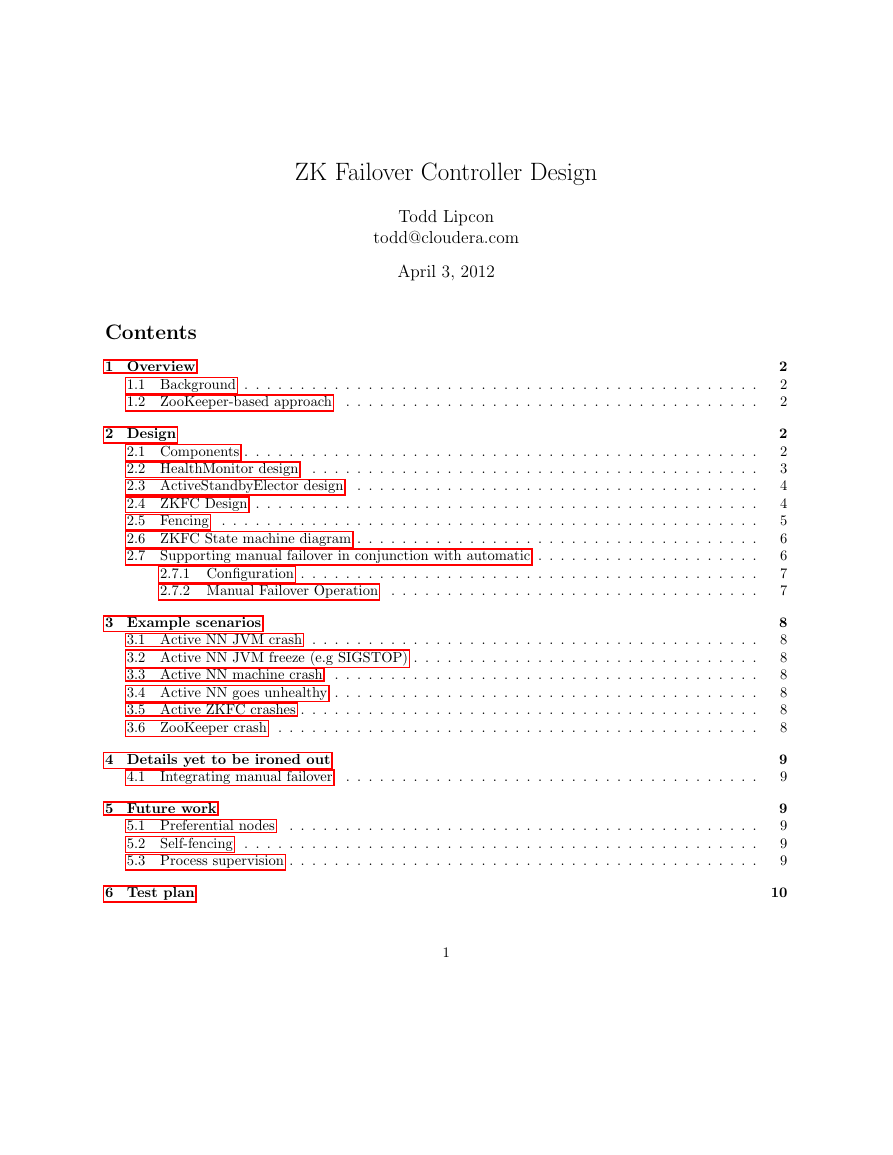
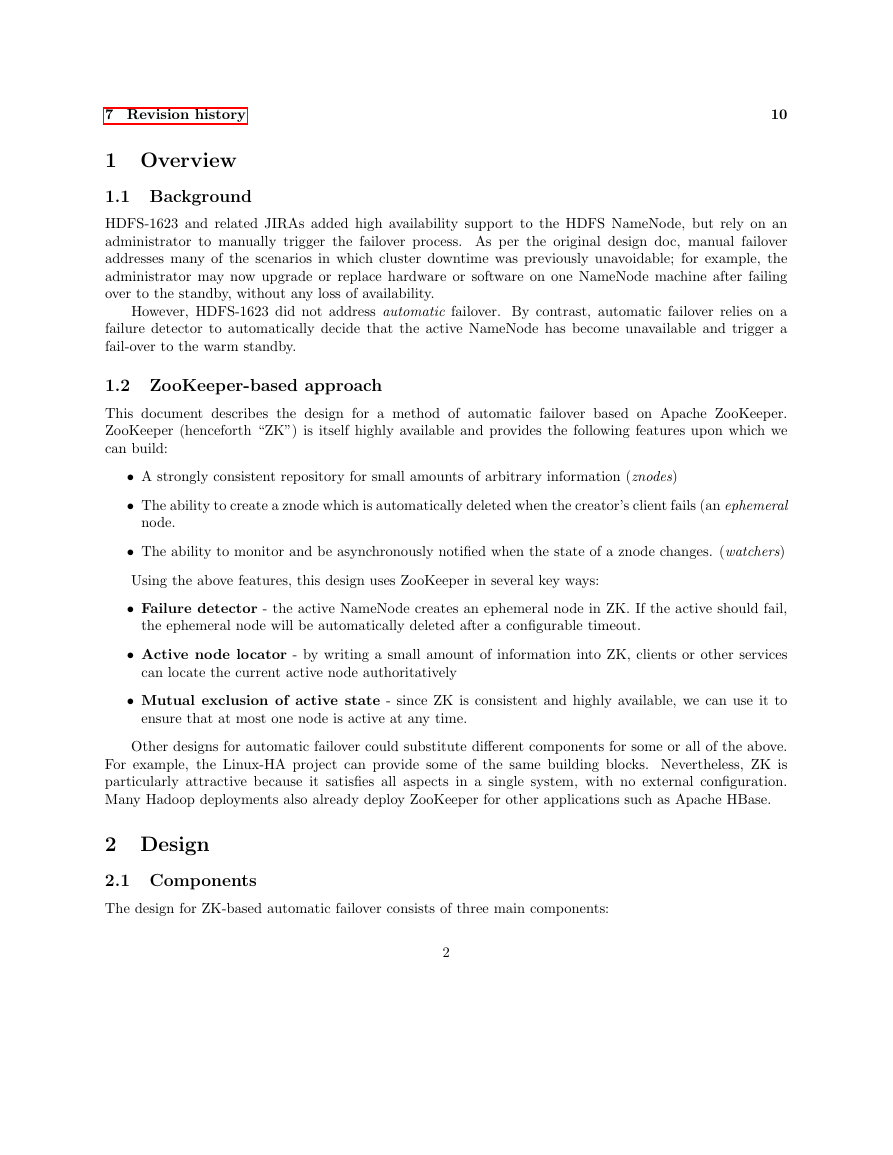
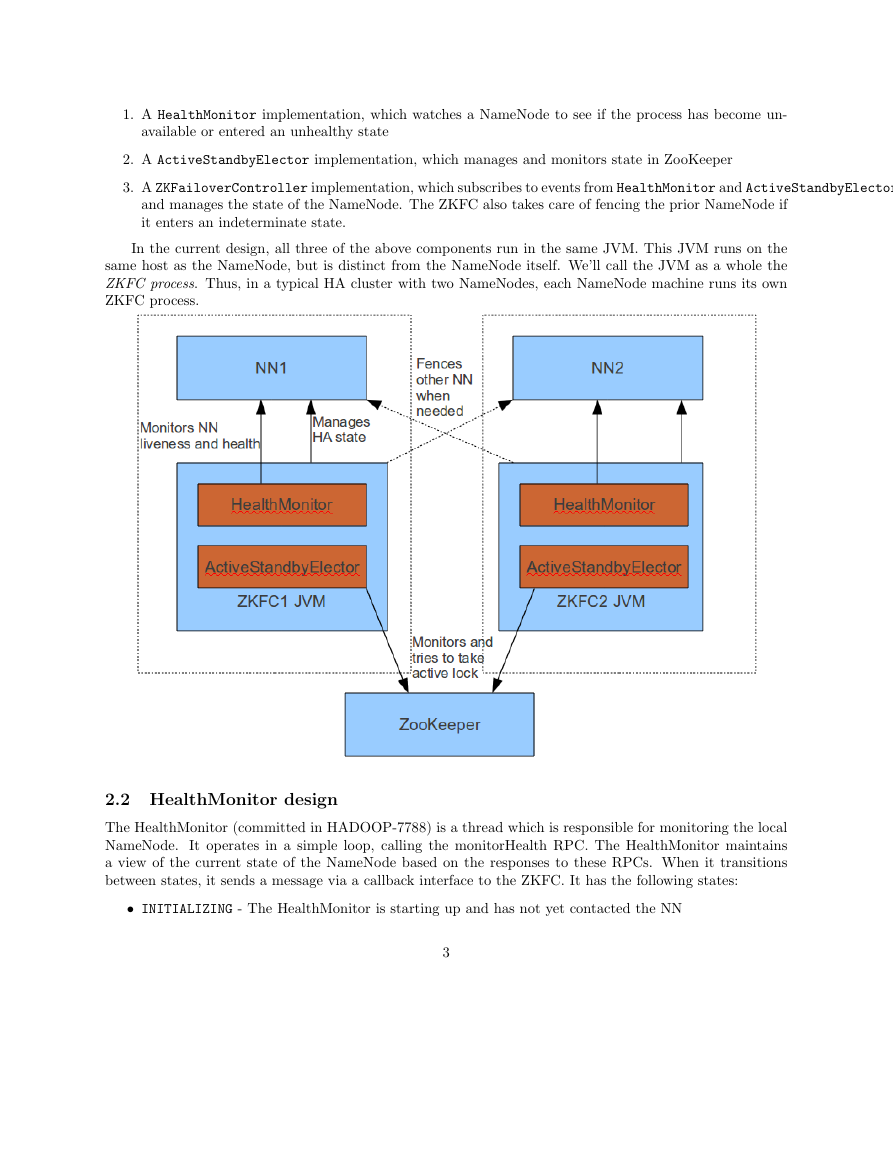
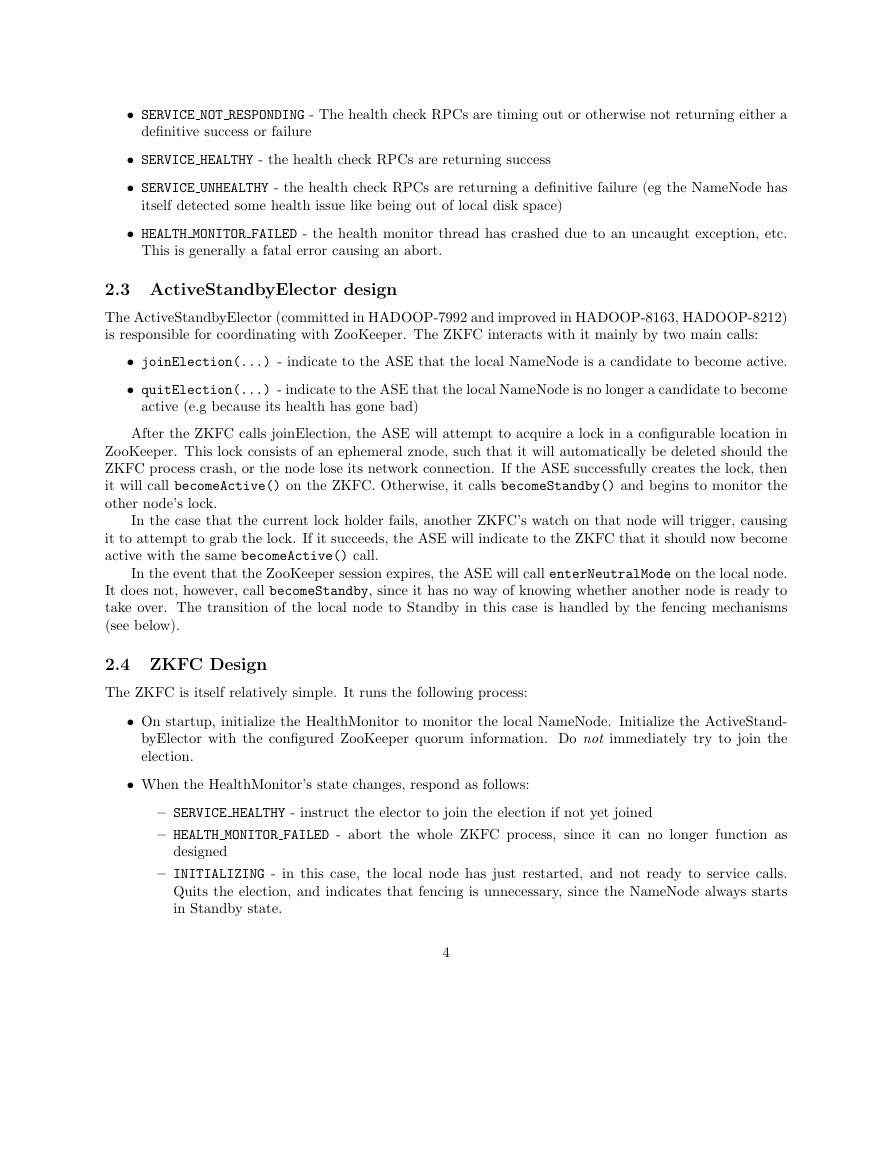
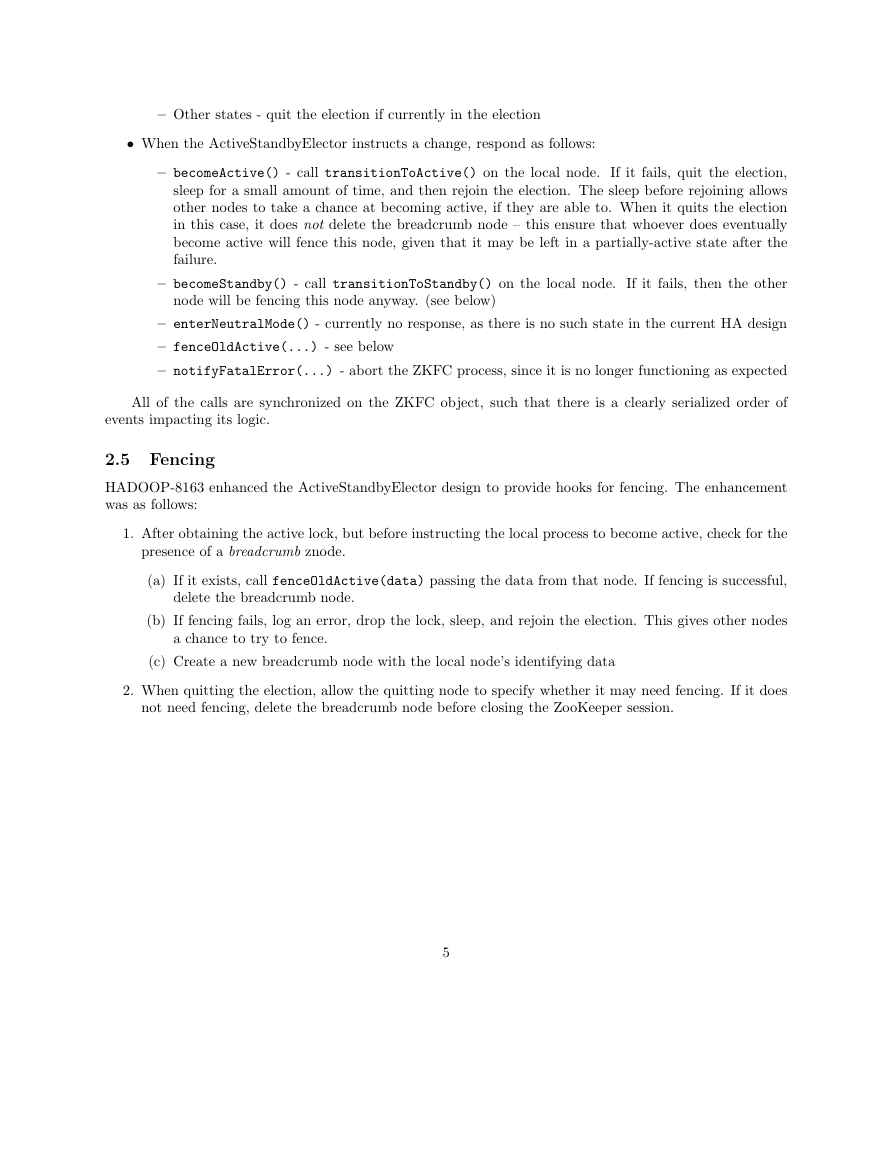
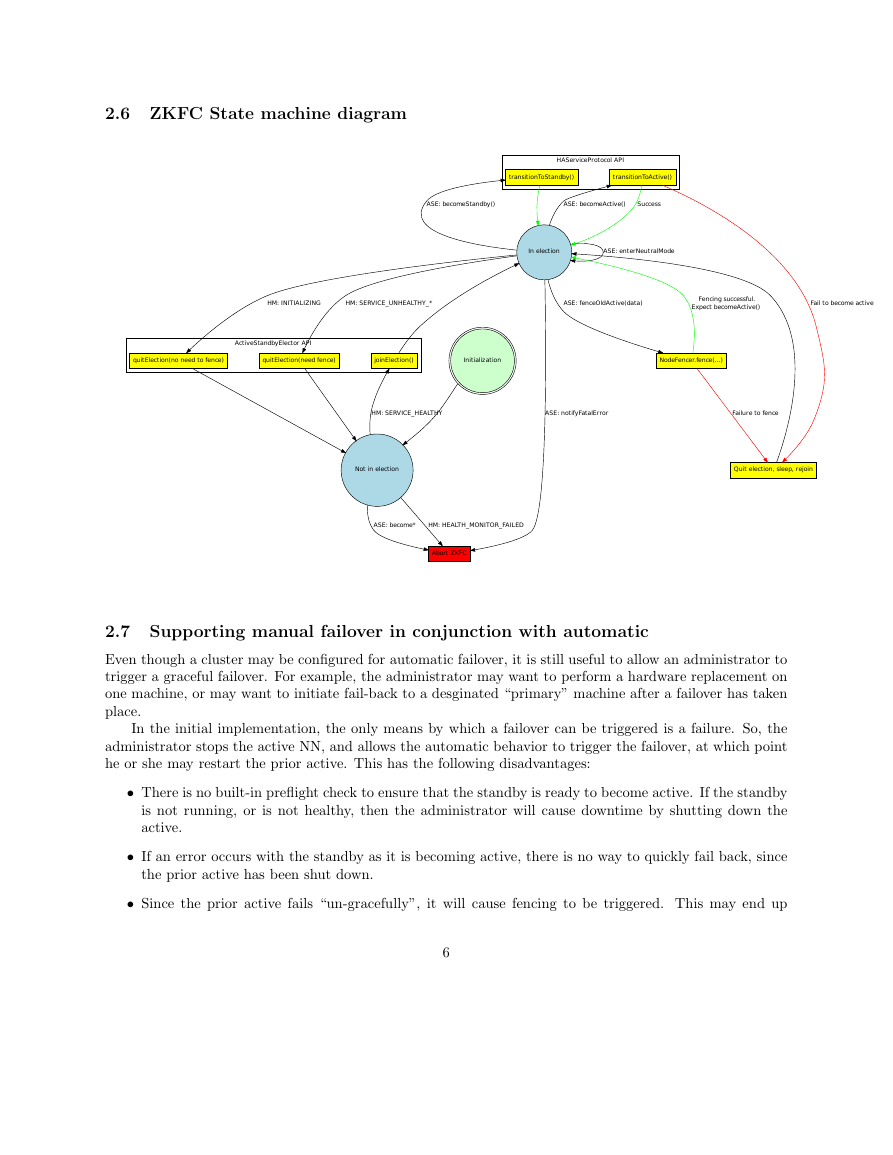
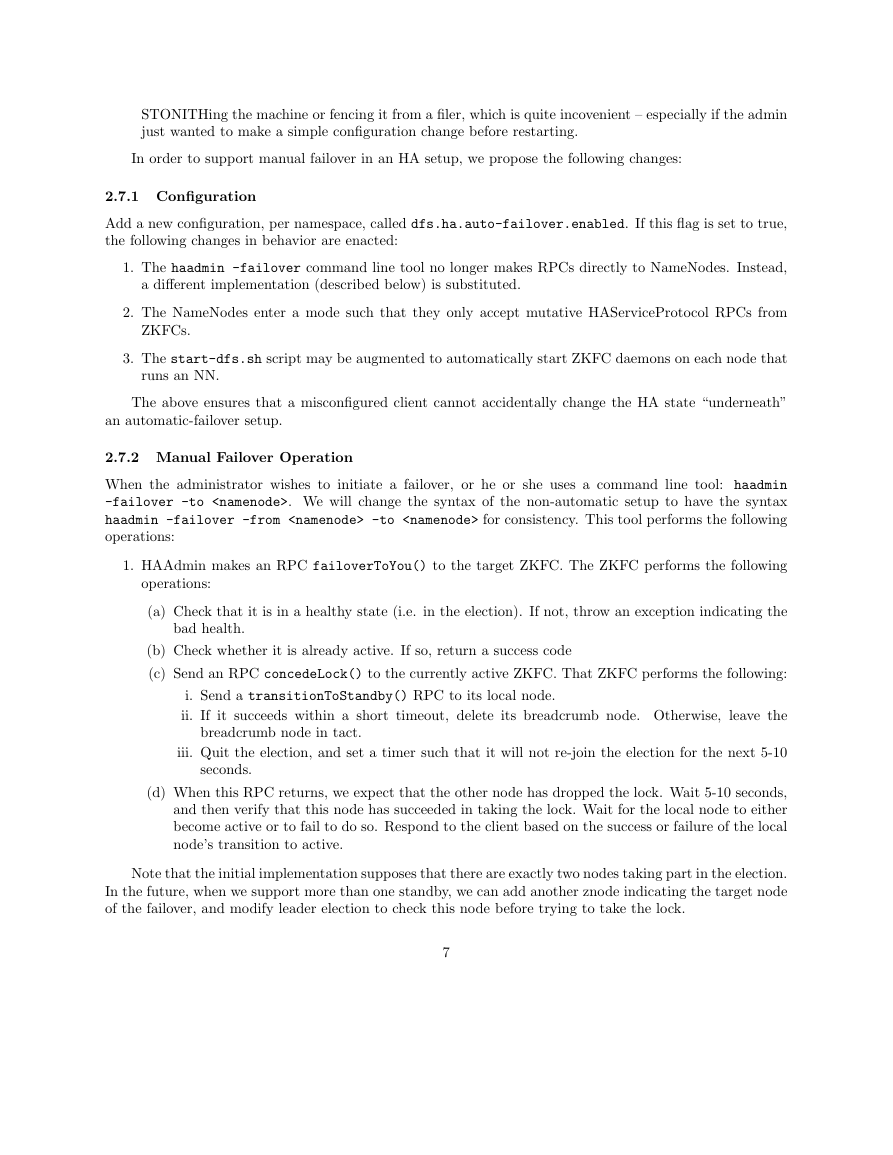
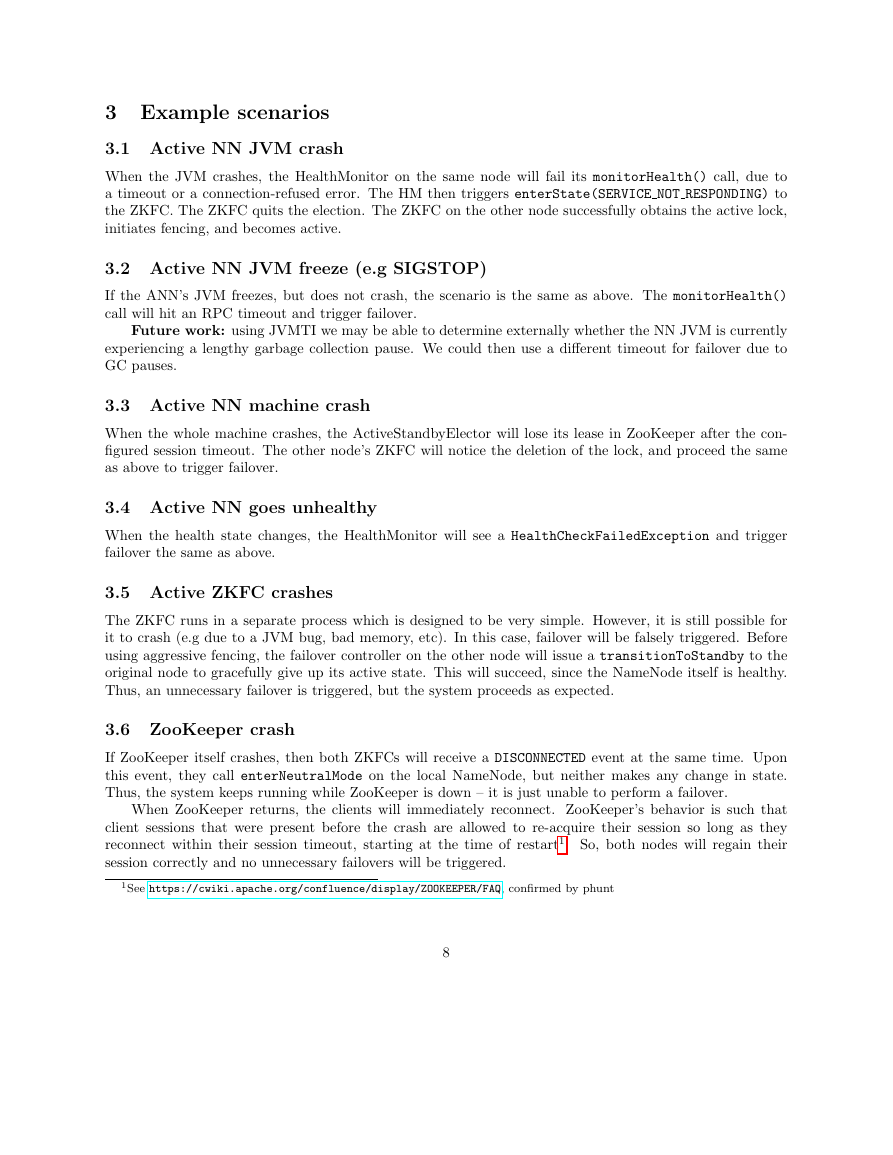








 2023年江西萍乡中考道德与法治真题及答案.doc
2023年江西萍乡中考道德与法治真题及答案.doc 2012年重庆南川中考生物真题及答案.doc
2012年重庆南川中考生物真题及答案.doc 2013年江西师范大学地理学综合及文艺理论基础考研真题.doc
2013年江西师范大学地理学综合及文艺理论基础考研真题.doc 2020年四川甘孜小升初语文真题及答案I卷.doc
2020年四川甘孜小升初语文真题及答案I卷.doc 2020年注册岩土工程师专业基础考试真题及答案.doc
2020年注册岩土工程师专业基础考试真题及答案.doc 2023-2024学年福建省厦门市九年级上学期数学月考试题及答案.doc
2023-2024学年福建省厦门市九年级上学期数学月考试题及答案.doc 2021-2022学年辽宁省沈阳市大东区九年级上学期语文期末试题及答案.doc
2021-2022学年辽宁省沈阳市大东区九年级上学期语文期末试题及答案.doc 2022-2023学年北京东城区初三第一学期物理期末试卷及答案.doc
2022-2023学年北京东城区初三第一学期物理期末试卷及答案.doc 2018上半年江西教师资格初中地理学科知识与教学能力真题及答案.doc
2018上半年江西教师资格初中地理学科知识与教学能力真题及答案.doc 2012年河北国家公务员申论考试真题及答案-省级.doc
2012年河北国家公务员申论考试真题及答案-省级.doc 2020-2021学年江苏省扬州市江都区邵樊片九年级上学期数学第一次质量检测试题及答案.doc
2020-2021学年江苏省扬州市江都区邵樊片九年级上学期数学第一次质量检测试题及答案.doc 2022下半年黑龙江教师资格证中学综合素质真题及答案.doc
2022下半年黑龙江教师资格证中学综合素质真题及答案.doc